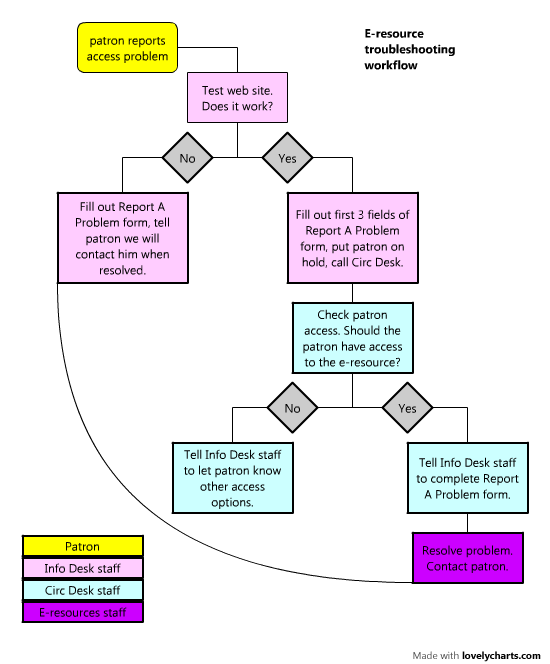my library has a wiki where library staff can report problems with databases or other technical issues; it’s my job to respond to and resolve the problems. i’d seen enough wiki entries that went something like this: “patron called to say he can’t access databases from home. swears he’s a current student” to know that we needed to establish a troubleshooting workflow for this issue. from the wiki entry i can’t tell what our staff did to troubleshoot the problem or how to get in touch with the patron to do any follow-up.
i started a conversation via email with our head of access and the systems librarian because i knew they were somehow involved in checking whether a patron is active in our system. i asked how they usually heard about issues like this and what they usually did when they got reports. while i waited for a response i interviewed some of our reference librarians to find out how they usually get reports of access problems and how they responded to the patron, wrote down what they said, probed for more information on certain points. i read the whole scenario back to them at that point and noted any further comments that they made. i got an email response from both the head of access and the systems librarian and they reported how they were involved in the process and what information they needed to troubleshoot.
from this wealth of responses i put together a workflow that addressed the salient points from the perspective of our head of access, systems librarian, and reference librarians. in the workflow i assigned certain steps to particular roles, so that it was clear what information they need to gather and to whom they need to direct that data. i sent the workflow to them via email and requested feedback. based on that feedback i asked a couple follow-up questions and tweaked the workflow. at the last iteration everyone involved agreed that the new workflow would serve us all well. at the end of the process we now have a troubleshooting workflow that everyone understands and is holistic rather than silo-ish.
as i reflected over the approach i used to gather information for this workflow it occurred to me that i had done an extended reference interview with each of the participants. with them i was able to diagnose the problem, probe for more information, clarify, provide a possible solution, and confirm. the last step will be as we use the workflow and evaluate if there are any further tweaks that need to be made.
here’s a link to a simple description of the steps of a reference interview on liswiki: http://liswiki.org/wiki/Reference_interview
here’s the workflow we’ve settled on as our first attempt:




